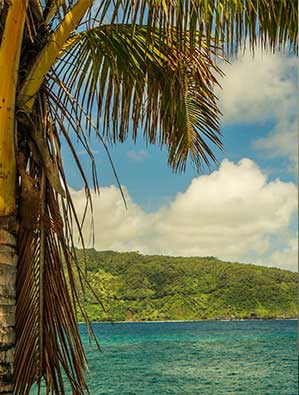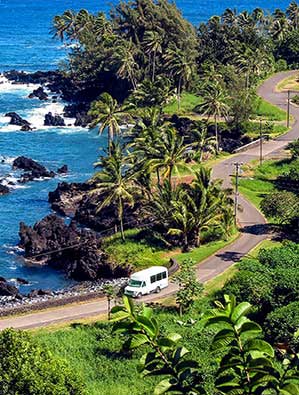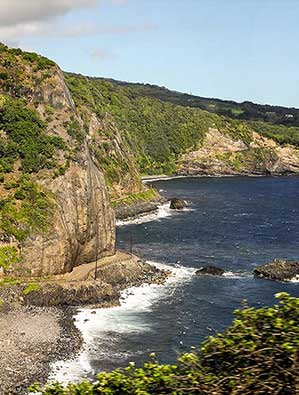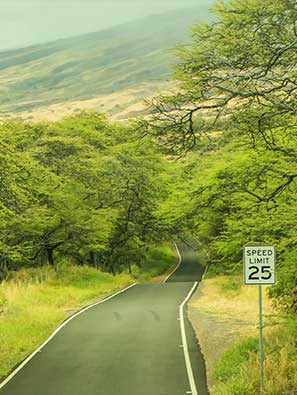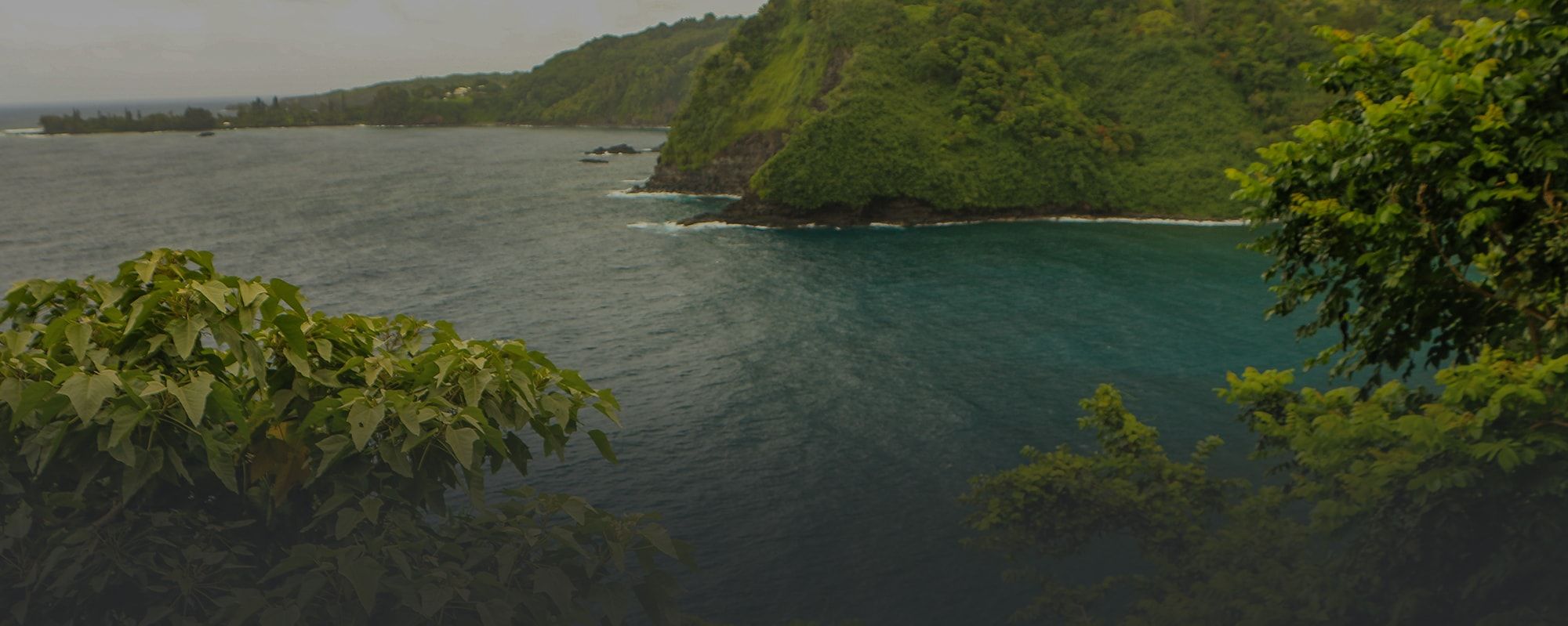
ROAD TO HANA MUST SEE
RAINBOW EUCALYPTUS
How often do you hear “some things are better when it rains”? Probably not too often, unless of course you’re on Maui! When wet, almost magically, the striped bark of this tree becomes an electric, hand-painted rainbow of hues that graces the trunk and branches in their entirety. Revealing an unique, vivid cacophony of colors that pops out of the surrounding jungle is what makes this “artsy” tree a must-see on Maui.
Although there is a small grove of these unusual, non-native trees located near mile marker #7 on the road to Hana, it’s not advisable to try to stop here. Be forewarned, it’s almost impossible to park, enter and exit your vehicle safely here. And, FYI - don’t even attempt it on the weekends!
Sublime scenery such as this can be found all along the road (you’ll see them if you’re going slow enough) and at the Ke'anae Arboretum (with much better parking options), which is located about a half mile past mile marker #16 makai (towards the sea or sea side).

WATERFALLS
Maui is world famous for it’s waterfalls. And, this is another one of those experiences that requires enough rain, so if it’s raining up on the mountain, you can start smiling. It makes for some great waterfalls along the road to Hana and if you’re concerned about it raining all day, don’t be, it will probably clear up by the time you get to Hana. It takes several hours for the rain water, depending on where it’s raining, to flow down to the sea.
Also, remember there are MANY waterfalls along the road to Hana. Stopping at the first few is not advisable, mostly because they’re not the best ones and parking can be a true challenge along this road. Parking in many spots is extremely limited and you don’t want to be the one stopping traffic in both directions trying to get a spot. Traffic also occurs due to there being so many seemingly ancient one-lane bridges, (more than half of the 59 bridges are one-lane). Most of the bridges were built in the early 1900’s!
Rain should always be taken into consideration, so keep in mind that flash floods and rockslides are common on the road to Hana as well, so be prepared with extra water, close toed shoes, bug spray, rain gear, food, towels, extra batteries for the camera and a lot of patience if mother nature starts causing a ruckus and the road to Hana becomes a parking lot due to weather conditions, an accident or a natural disaster.
Always drive with extreme caution on this road, unless of course you’d like to increase the HDOT’s death statistics. Remember, most of the tourists are busy snapping shots of a waterfall and are in awe and probably not looking for your car coming down the road, even if they’re driving! There is nothing scarier than seeing a driver holding a cell phone (whether talking, texting or reading a map) while attempting to drive this road!
The road to Hana’s beauty and mystery is distracting to say the least so if you’re the driver, keep your eyes on the road and let someone else talk on the cell, take the pictures and navigate. This 52 mile stretch of asphalt is also known as the “Divorce Highway” for a reason… and for it’s 620 hairpin-style turns, most of which have no barrier whatsoever to prevent your car from careening over a 200+ foot cliff! Again, please make safety your FIRST priority!

ROAD TO HANA MUST SEE
FLOWERS
Immediately welcoming you to the islands are the gigantic blooms of the Yellow Hawaiian Hibiscus, the state flower, while versatile Heliconia in all of it’s different colors and shapes wows even the most hard core botanist.
Hana is home to a kaleidoscope of color, gracefully stained to petals, stems and shoots of all kinds. An unparallelled floral fantasy awaits those adventurous travelers willing to drive the long road to Hana. While some of the fantastic flora found in the forest are indigenous to Maui, others are gorgeous non-native transplants from other parts of the world that have thrived in this tropical rainforest.
Many people don’t know that the Heliconia, Anthurium, Plumeria and Bougainvillea can bloom year round in Hawaii. Just another reason to bring extra batteries for the camera!
Flowering trees are also included in this category and the native Ohia doesn’t disappoint with it’s red tufted flowers. And, let us not forget the Plumeria, African Tulip, Jacaranda and Royal Poinciana aren’t native but they sure are pretty and if you live in a colder climate normally, these are a pleasure to behold in the winter months! Nothing wrong with a ton of flowers to admire when the everybody back at home is shivering and looking at barren landscapes, right? Just make sure you send them some pics to prove it (and maybe rub it in a little).

Fruit / Food Stands
Businesses serving prepared food are required to have a license, but, if selling fish, fruit, vegetables, flowers or leis in Hawaii then no license is necessary. That said, Hawaii is known for it’s excellent fresh fruit and food stands. It’s good to keep that in mind as you wait in line for your “made fresh from scratch” smoothie, banana bread, lunch or dinner. The fact that there is almost always at least a little line is a serious testament to the tastiness of local Hawaiian cuisine. Both tourists and locals alike are more than willing to wait for the delicious, exotic gourmet food these little shacks and mobile units turn out. Food and fruit stands/trucks have become a local subculture throughout Hawaii, but especially on the road to Hana.
So, don’t be hesitant to stop at one of these quirky, yet fabulously tasty munch-mobiles or smoothie shacks. Again, parking can be tricky so just take it slow, especially at feeding times (11am-1:30pm and 4pm-6pm) and do try to carpool (less cars on the road) and be patient when waiting for a parking spot, hand-crafted smoothie, banana bread or mixed plate.
Always a favorite is Auntie Sandy’s with the best banana bread on the entire island and well worth the drive - and the wait - to get one warm out of the oven for just $6 per loaf! Just take the road to Ke’anae at around mile marker #16 (on the left), take this road and you’ll see Auntie Sandy’s little shack on the right side, opposite the ocean. They do take credit cards but make sure to check their hours of operation.
Another fabulous foodie find along the road is Twin Falls farm stand. One of the few places on Maui where you can drink fresh squeezed (right in front of you) sugar cane juice. Their famous smoothies are noteworthy as well as are the falls and gardens.
Huelo Lookout is also another favorite stop for some tasty smoothies, crepes, shave ice and views. One smoothie in particular, called The Cure, is perfect to get the motion sickness from the road’s 600+ wicked turns or that hangover under control.
And let us not overlook the always wonderful Garden Gourmet Cafe. Located at mile marker #31 - it’s not to be missed. Some of the best Thai food you’ll ever taste can be found right here so don’t forget to stop if you’re a lover of Thai food. Be forewarned, they do not take credit cards and are open Mon-Sat 9-5:30 and closed on Sundays.

Coastal Cliff Views
There is no question that some of the most picturesque views of coastal cliffs anywhere on the planet are found here - along the road to Hana. If you just want a quick picture, just stop almost anywhere along the route and you’ll be treated to a breathtaking coastal panorama. However, if you’re a cliff lover, there are a few standouts that warrant a special stop.
Wai’anapanapa State Park, located at Mile Marker #32, has some of the most amazing coastal cliff views anywhere on Maui. Blow holes, a black sand beach, megalithic rock formations out in the lagoon and an ancient legend of a princess meeting her end at the hand of her husband in a cave here has made this spot even more enticing. Stay on trails as the rocks are excessively sharp and make sure you’re wearing closed toe shoes (sneakers or hiking boots are a good choice).

Volcanic Peninsula
Be sure to take the turnoff for Ke’anae road at Mile Marker #16. After stopping at Auntie Sandy’s for some banana bread, be sure to go to Ke’anae village and just take it all in because this is one of the most coveted spots for professional photographers. Keep in mind that there is absolutely NO SWIMMING here. Ke’anae peninsula is so jagged with lava rock that you might get dashed to your death upon the rocks if you were to take a dip. (Even the locals won’t swim here it’s so dangerous!). It’s advisable to make sure you wear appropriate footwear and adhere to all signage in this land of razor sharp rocks which are also light enough to move easily under foot even though they’re large - so be extra careful doing any climbing. And again… ABSOLUTELY NO FLIP FLOPS HERE, unless of course you want your feet shredded to bits!

Black Sand Beach
Wonderful Wai’anapanapa State Park has the darkest Black Sand Beach in all of Maui. (There are a couple of others but they’re more of a cocoa brown). It is “the spot” for getting that perfect black sand beach shot.
There are “No Swimming” signs posted but oftentimes foolish individuals will chance it, only to end up getting stung by moon jellies, stepping on urchins and encountering other notable ocean dwelling nasties that lurk beneath the waves in this lagoon. Unless you want to risk spending the rest of your vacation nursing yourself back to health, it’s advisable to obey the signs.
Also, don’t forget to slather on Reef Safe sunscreen frequently as the dark sand attracts the sun’s rays and the temperatures get considerably higher on black sand than white. Going for that perfect “lobster” should be done at a restaurant, not by getting seared on a daytrip. Also, make sure you don’t go barefoot. Plenty of tootsies traipsing over this beach have gotten second degree burns on hotter days. It’s been described as “stepping on a frying pan”. Black sand is beautiful but it’ll also burn you from head to toe if you’re not paying attention and taking all of the necessary precautions. So play it smart and enjoy!


